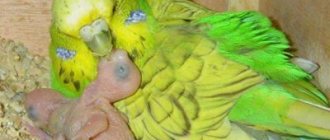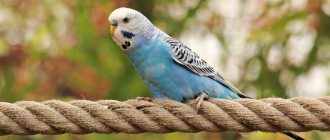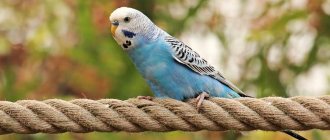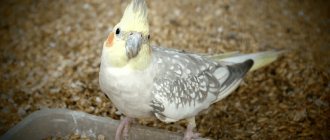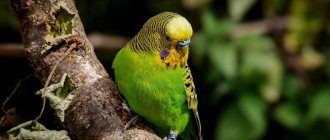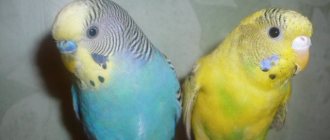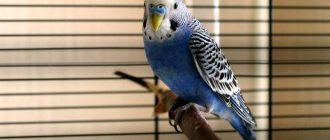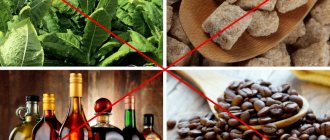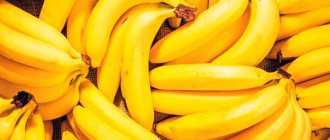Categories: Parrots How and what to feed a parrot? Tips for keeping small, medium and large parrots from an ornithologist veterinarian. Nutrition is an important point in keeping any animal. Food is fuel for the body. With improper feeding, metabolic disorders occur in the bird’s body, which can result in various diseases of organs and organ systems. Metabolism is many times faster than that of humans. For a bird, one day of poor nutrition is equal to a month or two for a person. Feed your pets, parrots, correctly!
Feeding of small parrots. What to feed your budgie?
Small parrots include the following, the most common species kept in captivity: budgerigars, Australian parrots, parakeets. The grain mixture is the basis of food for small parrots. It should include millet of different varieties, oats and canary seed. The composition includes flax seed, Abyssinian nougat, hemp seed, sunflower seeds (in no case should they be unroasted), meadow grass seeds. A huge selection of food is presented in pet stores and it is up to each owner which one to choose.
However, it is important to pay attention to the condition of the food even in closed packaging.
Under no circumstances should you feed food that has become damp. An unpleasant smell, mold, dirt should stop the owner of a budgie. Such food must be thrown into a bucket. The consequences of consuming such food are the most dire: the parrot may develop diseases that will be difficult to cure. Therefore, the best solution is to monitor the food. Choose sealed food in plastic packaging - such food is less likely to spoil. When feeding a budgie, pay attention to the fact that the bird should eat all the food, and not just select the ingredients. For quality nutrition for your pet. The parrot should completely eat all the food offered to it, and not select individual components from the grain mixture. Remember that for normal nutrition of a parrot, millet, as the main nutritional element, must make up at least half of its diet.
In addition, the bird’s diet must include green food, such as:
- vegetables
- fruits
- berries and herbs
- plant leaves.
There should always be mineral food in the cage: sepia (cuttlefish shell), chalk and a mineral mixture, which includes shell rock, coal and river sand.
How to give it to a bird
It is advisable to give green food to the wavy from childhood. Young birds are happy to try new foods, but become more and more picky as they age. Each pet has its own preferences, so even the most useful grass may not cause much delight in the wavy, so you will have to limit yourself to other plants.
If a parrot, for various reasons, refuses to even try grass food, then you can change its shape, size and even texture. Large leaves often arouse the curiosity of a small bird. Sometimes parrots prefer dried grass, which smells pleasant and also rustles unusually. If the birds are kept in pairs, then one wavy can teach the other to eat grass.
What to feed your cockatiel, rosella, kakarika?
It is generally accepted that medium-sized parrots include cockatiels, rosellas, lovebirds, kakarikis, lories, Senegalese and ringed parrots (the most common among ringed parrots is the Ringed Parrot). Food for medium-sized parrots typically includes: Millet (Italian, yellow, white and red millet) makes up approximately 70% of the total grain diet. Approximately 10% of the diet is sunflower seed, the remaining 20% of the diet comes from oats, buckwheat, flaxseed and other grains. It is also recommended to add various nuts to the food, but not much, so as not to cause metabolic disorders. Just like other types of parrots, medium parrots should not be deprived of fruit and vegetable food.
How to store
Grass brought from the street should be rinsed well with water, but without soaking, otherwise the plants will lose their beneficial properties.
Picked greens are stored in the refrigerator for no more than 5 days. To do this, it is advisable to use special plastic containers intended for food products. It is recommended to wrap bunches of greenery in paper towels and periodically spray them with water to prevent drying.
If the weed is dried, it can be stored on a windowsill or on a cabinet shelf.
What to feed your African Gray parrot?
Feeding large parrots has its own characteristics. For example, these birds in nature consume a minimum of grain feed, that is, under home-keeping conditions, the grain mixture of the total feed per day is approximately 30%. The remaining 70% is sprouted grains, fruits, vegetables, herbs, lettuce and other greens. Don’t forget about twig food, it also serves as a source of vitamins and nutrients for birds, especially in the spring. Despite the apparent similarity of birds, it is impossible to generalize their diets; it is worth creating an individual diet for each species. This is due to the peculiarities of the natural existence of birds and their natural needs. For example, some birds also need to add protein food (rosellas at any time of the year, a little, and Amazons during the breeding season), while for other species such a diet, on the contrary, is contraindicated.
Meadow grasses in the diet of birds
In addition to well-known cultivated plants and salads, there are meadow herbs, which of them can be given to parrots, scientists have found out.
Coltsfoot has a softening and expectorant effect. Can be given to pets during illness. It is not advisable to use flowers for feeding.
Common chicory contains inulin and protein substances. Seeds and young greens are suitable for feeding.
Wild strawberries are a delicacy for poultry. The whole bush and berries are used for feeding.
It is useful to introduce park and field crops into your pet’s diet. You just need to know which ones are useful and which ones are not.
The table will help you figure out which meadow or park grass you can give your parrot.
| Permitted crops | |||
| Plant | Wavy | Karela | Lovebirds |
| Acacia | fruit | fruits and flowers | fruit |
| Mustard | greenery | tops | greenery |
| Carrots (tops) | fruits and tops | fruits and tops | fruits and tops |
| Creeping wheatgrass | leaves | shoots | leaves and shoots |
| Purslane | flowers | flowers and shoots | flowers, shoots |
| Chicken millet | grain | grain | grain |
| Oats empty | seeds | spikelets, seeds | spikelets, seeds |
| Shepherd's Purse | seeds | grains | grains, leaves |
| Perennial tares | seeds | seeds | seeds |
| Yaskolka | flowers | leaves, shoots | greenery |
| Timothy grass | seeds | grains | seeds |
| Plantain | spikelets | spikelets, seeds | grains |
| Conditionally permitted crops | |||
| Plant | Wavy | Karela | Lovebirds |
| Parsley | forbidden | forbidden | forbidden |
| Sorrel | young shoots | young shoots | shoots |
| Dill | greens in small quantities | seeds and greens in small quantities | seeds and greens in small quantities |
| Prohibited crops | |||
| Plant | Wavy | Karela | Lovebirds |
| Heather | — | — | — |
| Periwinkle | — | — | — |
| All types of laurel | — | — | — |
| Spurge | — | — | — |
The table shows what grass can or cannot be given to a parrot. Herbs that are prohibited for consumption should absolutely not be introduced into your pet’s diet. Whether all types of domestic parrots can have conditionally permitted plants and which ones, it is up to the owner to decide. In this matter, the well-being of the bird and consultation with a specialist are important. The age-old debate among lovers of pet parrots about whether they can have dill and parsley leaves can be resolved if you carefully observe your pet.
The health of any wavy is affected by its diet. Owners should ensure that the bird receives as many vitamins and minerals as possible. There is not always enough store-bought food for this, so you need to regularly give your pet fresh greens.
To do this, you can buy grass for parrots or collect it yourself. But it is important to understand what greens are allowed and prohibited.
Treats for parrots. How to pamper your parrot?
You can offer almost anything from berries (birds will willingly eat blueberries, cherries, raspberries, strawberries, gooseberries, cherries, wild strawberries, currants (all varieties), serviceberry, honeysuckle, etc.) that you eat yourself, except, perhaps, watermelon . The thing is that quite often, various tricks are used to quickly grow and turn red a watermelon, including adding various fertilizers and “chopping” the watermelon. Often people themselves receive severe poisoning, but birds, alas, cannot tolerate such poisoning and die.
In the autumn, it is also recommended to give berries. Birds are excellent eaters of red and black rowan, viburnum, and hawthorn, which can be prepared in the autumn and stored in the freezer. If you have nowhere to pick berries, you can buy them at vegetable markets; in the fall, in the shopping arcades of summer residents, many people sell black rowan. As a last resort, most stores always sell frozen cranberries, black currants, etc. They also eat rose hips with great pleasure. Dried rose hips are now sold in almost every supermarket; they can be soaked and given to birds. The berries are very healthy and contain a huge amount of vitamins, which are so necessary in the fall. By the way, berries have an excellent effect on the color of plumage; they make growing feathers brighter.
Features of collection
Anyone can figure out which plants are appropriate to give to a bird in order to provide its body with useful microelements. But at the same time, certain rules are taken into account, on the basis of which the grass is collected and stored.
These include:
- It is not recommended to pick plants that grow next to the roadway or railway tracks, since here they are heavily polluted and often infected with parasites;
- for collection, it is advisable to choose open clearings in the forest, lawns located in parks, as well as fields or forest strips, since here it is possible to obtain clean, healthy and fresh greenery;
- when choosing grass, you need to carefully examine its leaves, since they must be dense and have an even color;
- Leaves that have any stains should not be picked, and leaves with darkened edges should not be thrown away;
- preference is given to young greens, which have a soft structure, and also do not have too strong a taste, which repels many parrots;
- any herb is introduced gradually, for which the bird is offered a small amount of the plant, and if there is no negative reaction in the form of diarrhea or vomiting, then the dose can be increased daily;
- To create a varied diet, it is recommended to combine different herbs.
Some pet stores grow various plants themselves, which are sold in small plastic containers, and they are affordable, and you don’t have to worry about the grass being infested with parasites.
What is good for a parrot?
Fruits, vegetables and herbs that can and should be given to birds:
- Apricot
- A pineapple
- Orange*
- Banana (do not overuse)
- Pear
- Figs
- Kiwi
- Lemon*
- Mandarin
- Nectarine
- Peach
- Pomelo*
- Plum
- Feijoa (not much)
* - for citrus fruits, it is recommended to remove all membranes and white skins before giving to the bird, leaving only the juicy pulp. Small parrots should not be given much.
- Broccoli (boil without salt and spices or blanch)
- Zucchini, zucchini,
- Kohlrabi (blanch)
- Corn (in season, milky ripeness),
- Carrots (carrot tops are also recommended to be given to birds, but in season),
- Cucumber,
- Sweet bell pepper (We especially like medium-sized birds, but you can give it to everyone)
- Radishes (you can also give radish tops)
- Turnips (blanch)
- Salads: cabbage, leaf and lettuce (Iceberg lettuce is especially loved by birds, it is sweet)
- Beets (can be blanched, can be given raw if you have grown them yourself, for example; You can also give beet tops)
- Celery (Only greens!!)
- Tomato (without stems and leaves)
- Turnips (blanch, you can use greens)
- Pumpkin
- Cauliflower and Chinese cabbage (blanch)
- Dried fruits can be given only homemade to avoid poisoning of the bird. It is recommended to steam it before giving it to the bird.
The following should absolutely not be given to birds for consumption:
- Avocado
- Mango
- Papaya
- Persimmon
- Potatoes (due to high content of pesticides, herbicides and starch)
- Onion
- Garlic
- Sorrel
- Cilantro
- White cabbage
- In moderation:
- Parsley
- Dill
- Grape
- Pomegranate
- Melon (only in season and a little)
- Arugula, spinach (in the absence of kidney pathologies).
- VII. Feed rate per day per bird:
- Small parrots - 20-25 grams of grain (on average, this is 2 teaspoons) + unlimited amount of green food,
- Medium parrots - 30-35 grams of grain (1.5 tablespoons) + unlimited amount of green food,
- Large parrots - 40-50g, i.e. approximately 2 tablespoons + unlimited amount of green food.
Greens from the human diet that are dangerous for pets
There are endless debates among parrot breeders about whether it is possible to give parsley and dill to a parrot in unlimited quantities. Scientists have their own authoritative opinion regarding dill in a parrot’s diet and the question of whether it can be given.
Important! All types of herbs - dill, parsley, celery - contain a large amount of essential oils, which are potentially dangerous to the health of the bird, as they are toxic to it. It is not advisable to give your parrot dill and parsley leaves.
Bird lovers, when asked whether parrots can eat dill, answer positively. It turned out that dill can be given in small quantities; it will not harm the bird. Moreover, dried dill can be added to the parrot’s main diet or as a supplement for respiratory diseases.
Spices can harm the bird’s body only if it is sick. The veterinarian will decide whether and in what quantities dill can be given to the parrots. It is not always possible to detect abnormalities in the functioning of a pet’s body by sight. To avoid unpleasant situations, you need to make sure exactly what kind of grass you can give to your bird.
Regarding parsley and whether a parrot can have it, the opinion is different: absolutely not. To the question about celery and whether it can be introduced into a parrot’s diet, the answer is also clear: this spicy herb is dangerous for birds.
Home germination
At home, you can sprout different herbs, for example, buckwheat, rye and even oats. With the help of such actions, the optimal diet of the wavy is ensured even in winter.
The process is divided into stages:
the seeds are sorted as empty grains are removed;- the seed is soaked for 30 minutes in water;
- shavings or soil are added to the container;
- the seeds are distributed on top in an even and dense layer;
- they are covered with sawdust or soil, and also watered with warm water;
- the container is covered with film;
- the container is moved to a warm place.
Literally after 4 days the first shoots appear, and after another 7 days you can pamper the bird with fresh herbs.
